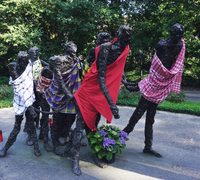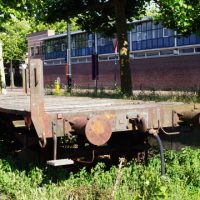The Black Archives
Zeeburgerdijk 19b
The National Institute for the Study of Dutch Slavery and its Legacy (NiNsee) was founded in 2002 simultaneously with the National Slavery Monument in the Oosterpark. It was the active, living component of the monument and at the time the only institute with the important mission of researching the history of slavery and organising activities to give that history a place, such as the Ketikoti festival. The institutionalisation of knowledge about slavery was an important step towards a more complete and balanced picture of Dutch history.
However, from 2011 on, at the instigation of the Minister for Education, Culture and Science Halbe Zijlstra, the Dutch government began massive spending cuts in subsidies to the Dutch cultural sector. The consequences of that dramatic move are still with us today. From then on institutes had to become self-sufficient and their survival was made to depend on visitor statistics. Unlike tourist attractions like the Museumplein, other organisations rapidly ran into problems. Among them were the institutes that targeted the under-researched story of the colonial past, recognition of which had only just begun. The Tropenmuseum, the Maritime Museum, the World Museum in Rotterdam and the NiNsee were among those who were seriously affected. The Tropenmuseum was forced to close its library and theatre, the NiNsee continued to organise the Ketikoti festival but switched to survival mode. Research and the development of knowledge had to be pushed into the background. One step forward in 2001, two steps back in 2011.
Still, the need to give Black perspectives a place in the Netherlands remained unaltered. That it has revived in the last few years can be seen, for example, from the debate on Zwarte Piet, the Black helper of St Nicholas, the questioning of names in the public space, and the creation of political parties dedicated to the decolonisation of our legacy. One of the initiatives that play a role in that is The Black Archives, housed in the premises of Vereniging Ons Suriname (Our Surinam Association). The Black Archives is a historical archive that not only holds a large collection of books and artefacts with racist symbols but also organises exhibitions, lectures and debates. ‘It is a place where people can meet and talk on the basis of different perspectives’ says Mitchell Esajas, one of the founders of the archive that got off to a fortuitous start a few years ago with the donation of a unique book collection. ‘A place where the legitimacy of these perspectives is not called into question. For in the regular institutes power structures still influence which knowledge is regarded as legitimate or not, which archives are consulted and which not’. Esajas sees exhibitions as a good way of bringing the long history of the struggle against racism to life. ‘Art can involve people in the story and reach a larger public than a book’.
Awareness of the colonial past is slowly growing in the Netherlands. For instance, The Correspondent and The Black Archives created the Month of Silenced History, which resulted in a series of articles disseminating knowledge that is still absent from the school books. For the Dutch pavilion at the 2019 Venice Biennale, they are working with the artist Iris Kensmil on an installation in which the work of Black utopian artists is shown. And for 2020 even the Rijksmuseum, which in the past only paid attention to the success stories of history, has programmed an exhibition on the history of Dutch slavery. As a result, the recognition of the shadow side of Dutch history is gaining a more prominent place in the collective memory.
The exhibition Black & Revolutionary on the anti-racism campaigners Hermina and Otto Huiswoud is on until 8 July and the archive of The Black Archives is open to the public during most of the summer months. There will be a new exhibition in 2019. See here for more information about the archive and the programme. And here more on the place of the colonial post in museum policy.





